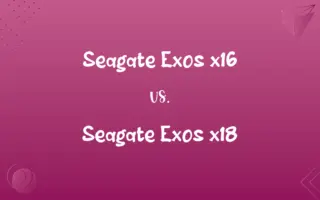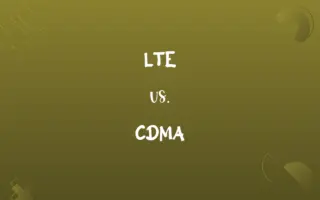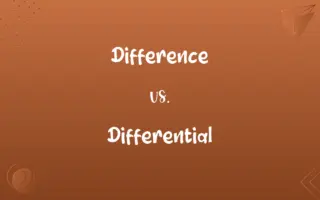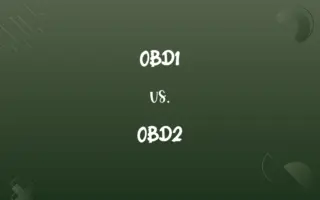Data Encryption Standard vs. Advanced Encryption Standard: Know the Difference

By Shumaila Saeed || Published on February 19, 2024
Data Encryption Standard (DES) is an older, 56-bit key encryption algorithm, while Advanced Encryption Standard (AES) is a newer, more secure standard using 128, 192, or 256-bit keys.

Key Differences
The Data Encryption Standard (DES) was established in the 1970s as an encryption standard using a 56-bit key, making it vulnerable to modern brute-force attacks. In contrast, the Advanced Encryption Standard (AES) was introduced in 2001, offering key sizes of 128, 192, or 256 bits, significantly enhancing security against brute-force attacks. DES's shorter key length is a primary weakness compared to AES's longer and more secure key options.
Shumaila Saeed
Feb 19, 2024
DES employs a symmetric-key algorithm based on a Feistel network; it encrypts data in 64-bit blocks, making it less efficient for large data sets. AES, however, uses a substitution-permutation network and operates on 128-bit blocks, providing better efficiency and security for encrypting large volumes of data. This structural difference in block size and algorithmic approach marks a significant advancement from DES to AES.
Shumaila Saeed
Feb 19, 2024
The Data Encryption Standard was widely adopted in the late 20th century but faced criticism for its shorter key length and vulnerabilities. Advanced Encryption Standard, on the other hand, quickly became the standard for government and commercial data encryption due to its higher security level. AES's adoption reflects a shift in cryptographic standards in response to increasing data security needs.
Shumaila Saeed
Feb 19, 2024
DES operates through 16 rounds of encryption, each using a different 48-bit key generated from the main 56-bit key. In contrast, AES's number of rounds depends on the key size: 10 rounds for 128-bit keys, 12 for 192-bit, and 14 for 256-bit keys. This difference in encryption rounds and key management demonstrates AES's more complex and secure approach.
Shumaila Saeed
Feb 19, 2024
While DES was officially withdrawn as a standard by the National Institute of Standards and Technology (NIST) in 2005, it laid the groundwork for modern encryption techniques. AES, certified as a federal standard by NIST, is now used in a wide range of applications, including SSL/TLS for internet security, signifying its broad acceptance and robustness as an encryption standard.
Shumaila Saeed
Feb 19, 2024
ADVERTISEMENT
Comparison Chart
Encryption Type
Symmetric-key algorithm based on Feistel network
Symmetric-key algorithm using substitution-permutation network
Shumaila Saeed
Feb 19, 2024
Security
Vulnerable to brute-force attacks
Highly resistant to brute-force attacks
Shumaila Saeed
Feb 19, 2024
Adoption and Current Use
Phased out, replaced by AES
Widely used in government and commercial sectors
Shumaila Saeed
Feb 19, 2024
ADVERTISEMENT
Data Encryption Standard and Advanced Encryption Standard Definitions
Data Encryption Standard
DES is a pioneer encryption standard replaced due to security limitations.
After DES, many organizations transitioned to more secure encryption methods like AES.
Shumaila Saeed
Jan 24, 2024
Advanced Encryption Standard
AES encrypts data in 128-bit blocks, providing enhanced security and efficiency.
AES is used in securing Wi-Fi networks through WPA2.
Shumaila Saeed
Jan 24, 2024
Data Encryption Standard
DES uses a series of 16 encryption rounds with key permutations.
DES's multiple encryption rounds were initially considered secure against hacking.
Shumaila Saeed
Jan 24, 2024
Advanced Encryption Standard
AES is a globally recognized encryption standard for secure data transmission.
Online banking systems rely on AES for encrypting transactions.
Shumaila Saeed
Jan 24, 2024
Data Encryption Standard
DES is a symmetric-key algorithm for encrypting electronic data using a 56-bit key.
Banks initially used DES for securing ATM transactions.
Shumaila Saeed
Jan 24, 2024
ADVERTISEMENT
Advanced Encryption Standard
AES offers variable encryption rounds based on key size for added security.
In AES, a 256-bit key uses 14 encryption rounds.
Shumaila Saeed
Jan 24, 2024
Data Encryption Standard
DES encrypts data in 64-bit blocks, making it suitable for moderate data sizes.
DES was used to encrypt email communications in the 1990s.
Shumaila Saeed
Jan 24, 2024
Advanced Encryption Standard
AES is a symmetric key encryption standard using keys of 128, 192, or 256 bits.
AES is commonly used to encrypt sensitive government data.
Shumaila Saeed
Jan 24, 2024
Data Encryption Standard
DES was the federal encryption standard before being superseded by AES.
U.S. government documents were encrypted using DES until AES was adopted.
Shumaila Saeed
Jan 24, 2024
Advanced Encryption Standard
AES is the preferred encryption standard due to its resistance to brute-force attacks.
AES is used for encrypting user data in modern smartphones.
Shumaila Saeed
Jan 24, 2024
Repeatedly Asked Queries
Why was DES replaced by AES?
Due to DES’s vulnerability to brute-force attacks and limited key size.
Shumaila Saeed
Feb 19, 2024
What is AES?
AES is a symmetric encryption standard using 128, 192, or 256-bit keys.
Shumaila Saeed
Feb 19, 2024
What type of algorithm is DES based on?
A Feistel network-based symmetric-key algorithm.
Shumaila Saeed
Feb 19, 2024
In what applications is AES commonly used?
In government, commercial sectors, and internet security.
Shumaila Saeed
Feb 19, 2024
What is DES?
DES is a symmetric-key encryption algorithm using a 56-bit key.
Shumaila Saeed
Feb 19, 2024
How many rounds of encryption does AES use?
10 rounds for 128-bit, 12 for 192-bit, and 14 for 256-bit keys.
Shumaila Saeed
Feb 19, 2024
Can AES be cracked easily?
No, it's designed to withstand modern cryptographic attacks.
Shumaila Saeed
Feb 19, 2024
Who standardized AES?
The National Institute of Standards and Technology (NIST).
Shumaila Saeed
Feb 19, 2024
Is AES more efficient than DES?
Yes, due to better security and efficiency in processing large data sets.
Shumaila Saeed
Feb 19, 2024
Did DES influence modern encryption?
Yes, it laid the groundwork for current encryption techniques.
Shumaila Saeed
Feb 19, 2024
Share this page
Link for your blog / website
HTML
Link to share via messenger
About Author
Written by
Shumaila SaeedShumaila Saeed, an expert content creator with 6 years of experience, specializes in distilling complex topics into easily digestible comparisons, shining a light on the nuances that both inform and educate readers with clarity and accuracy.






































































